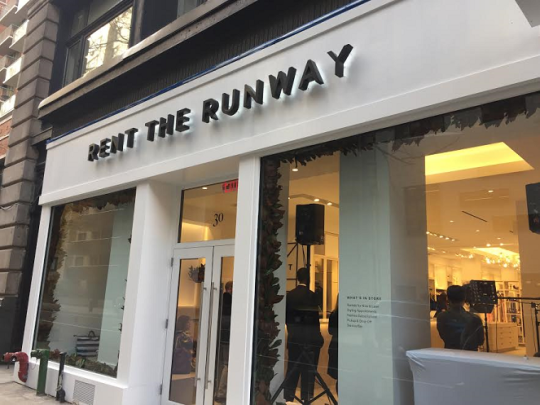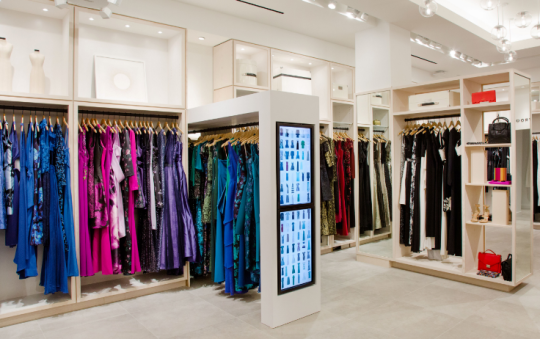By Glenn Taylor, Senior Editor

With its new flagship store location that opened in Manhattan on Dec. 6, fashion rental retailer Rent the Runway is the latest signal that the “store of the future” is here. With a “Dream Closet,” its own bar-like concierge and a personalized Style Studio, the 5,000-square-foot store is three times the size of any of the retailer’s existing stores and rotates the merchandise that appears on its floor daily.
Last Friday, Dec. 9, I had the opportunity to take a tour of the recently opened store to capture the experience firsthand. Given the constant struggle retailers face in building out omnichannel experiences, the Rent the Runway flagship offers three key lessons for brands seeking to further engage consumers:
- Leverage full inventory visibility to extend store experience value;
- Cater to on-the-go shoppers via mobile and open communication; and
- Emphasize striking visuals within the store.
‘Dream Closet’ Extends In-Store Browsing Experience To Cloud

The beauty — and challenge — of the company’s target market is that the “Rent the Runway Girl” can be any woman, whether she’s a 70-year-old renting a dress for a wedding or a 22-year-old renting for a holiday party at her first job. The potential customer base is there for the taking, but it all hinges on creating a personalized, convenient experience that meets her needs at every step.
Enter the “Dream Closet,” an experience designed to serve as an extension of the shopper’s own closet. The experience includes four Samsung 32-inch endcap displays that highlight various clothing styles and show graphic formations for more than 200,000 fashion choices. The touch overlay on each screen provides users with the ability to check out a large amount of inventory that is not on display within the store.
“While it may look like there are 10 purple dresses, the reality is there are 10,000 purple dresses,” said Maureen Sullivan, President of the Core Fashion Business at Rent the Runway. “We wanted to remind the customer that if she wanted to take something from here today, great. But if she rents tomorrow, a week or two weeks from now, she doesn’t need to be limited to what’s in this Dream Closet. She has access to our entire closet in the cloud.”
Shoppers can make appointments for personal styling sessions, with pricing ranging from $25 to $75 depending on whether they are trying on business casual clothing or a dress for a wedding. The stylist will pick out styles, ask the shoppers about her preferences and build a personal data profile based on this information.
RTR Bar, Mobile Features Cater To On-The-Go Shoppers
As many as 90% of Rent the Runway’s six million Unlimited subscribers work for a living, making this the Rent the Runway Girl’s common characteristic regardless of age, size or color preference. This is important because the retailer has to meet these on-the-go consumers’ needs at all times, and in quick order.
The brand built its “RTR Bar” as its store centerpiece, a place where consumers can engage with iPad-equipped fashion stylists to quickly pick up, drop off, or exchange rented merchandise. Shoppers strapped for time can even check themselves out at a tablet stand by the door, and they will receive a text when one of the 16 fitting rooms is open.
Rent the Runway supplements the in-store experience with its mobile app, and has recently added two new features: RTR Now and RTR Concierge. With RTR Now, consumers can get a real-time view of the store’s inventory on the mobile phone, while RTR Concierge enables shoppers to interact with store associates anywhere.
“In our dream scenario, before she’s even walked through these doors, she’s chatting with us,” Sullivan said during the tour. “She’s in an Uber and she just browsed everything in the store that’s in her size, so she wants to try on three dresses and have them in a dressing room ready to go. Technology is interwoven throughout the entire store. It’s the underpinning of everything we do in the store, from how the associates service our customers to how we want the shopper interacting with the store even before she’s physically here.”
Visuals Set The Store Apart
Although these personalized, convenient experiences drive the Rent the Runway experience as a whole, the visuals inside the store are just as big a factor in making the store relatable.
Immediately upon entering the store, you can turn right to see a 75-inch Samsung digital video wall that highlights Rent the Runway’s exclusive editorial content. The wall is made up of nine displays designed to engage customers and advertise the RTR style at all times.
In the back of the store, shoppers can find Samsung’s 55-inch ML55E Mirror Display screen, which is designed to provide an interactive screen for makeup touchups to accompany shoppers trying on the latest styles and trends.
While both these displays and the Dream Closet experience take shape in various areas of the store, they aren’t overwhelming in the slightest and feel very much appropriate. The store layout is very minimalist, with all the dresses lined up as they normally would be in an average shoppers’ closet, except that they are color coded. The colorful dresses and accessories contrast heavily with the white walls and tan dressers on display, making the products stand out even more.
Seeing how retailers often have cluttered stores where it’s impossible to find a specific style or brand you are looking for, the open space and closet-like atmosphere felt like a breath of fresh air from a consumer perspective.
Although still small in brick-and-mortar scale, Rent the Runway has illustrated that it can extend its shopping experience effectively within its limited space. With more shoppers gravitating toward whatever channel fits them best at the time, brands must discover what value their stores are bringing to the table and find ways to integrate those experiences with these channels.






